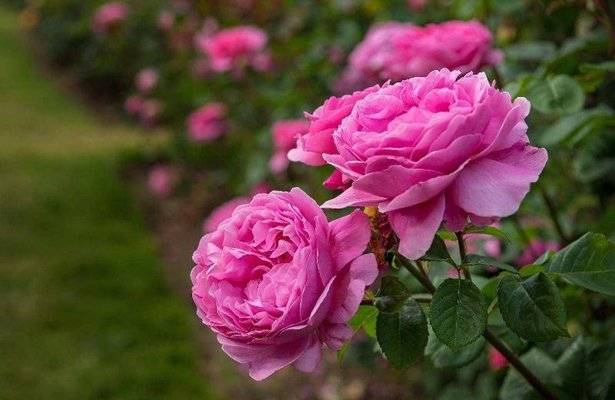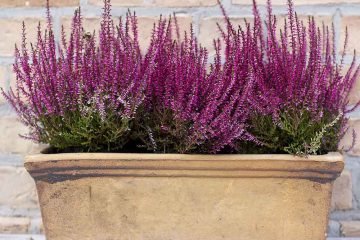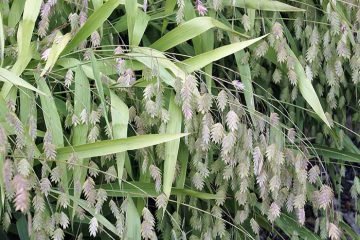Damask rose flower specifications
-
Scientific name : Rosa damascena
- Order : Rosales
- Family : Rosaceae
- Genus : Rosa
- Species : R. damascena
- English names : tag-tsi meto, Persian rose, monthly rose, damask rose, York and loncoster rose
- German name : Roos, Damaszenerrose
- Native to the region : Mostly in Asia, with species in Europe, North America and Northwest Africa
Persian Rose is a plant with the scientific name of Rosa Damascena Mill, from the genus Rosaceae. It is one of the most valuable export plants because of producing one of the most expensive essential oils known as ‘Liquid Gold’.
It is a deciduous shrub that grows up to 1-2 meters. The stems are densely armed with stout, curved prickles and stiff bristles. The leaves are pinnate, with 5-7 ovate, rectangular, and serrated leaflets with a length of 2-6 cm. The petioles are prickly, and the leaves are dark green. The roses are in pink and red colors in two rows with hairy petioles. The fruits are ovate, 2.50 cm long, barbate, and red.
read more : Everything about hydrangeas : How to Plant & care for Hydrangea

Global Distribution
This plant is cultivated in most parts of the world, but in terms of the amount of essential oil and fragrance, Persian Rose is the best species worldwide.
Damask rose flower in Iran
There are 13 native species of damask rose flowers in Iran. Damask rose flowers are harvested only once a year in Iran, but due to the four seasons in Iran, such flowers can be grown in most parts of Iran, and it is possible to scientifically improve the aroma and essence of those flowers. But tissue culture is necessary to preserve the endangered species of damask rose in Iran.
The cultivated areas of damask rose flower are mostly foothill areas and arid and semi-arid climates with mild and dry summers and cold winters.
Although damask rose flower grows in different climatic and natural conditions, but in terms of quality, it should be grown in a special environment where the summer and semi-arid climate is the best environment for the quality of its aroma.
This flower grows best in temperatures of 15 to 21 degrees. But if the temperature difference between day and night is 5 to 10 degrees, the flowers will be more fragrant.
At present, damask rose flowers are cultivated in 14 provinces of the country. The largest plain of damask rose flower in the world is located in the villages of Navayegan and Laizengan (Darab functions) with an area of about 5000 hectares where damask rose is cultivated by dry method.
The best and highest quality damask rose flowers are harvested in the fields of Kashan city in Barzak, Joshqan and Kamo, Niasar and Ghamsar districts and three dozen.
Other areas under damask rose flower cultivation include Kerman, Fars (Meymand), Isfahan (Kashan) and East Azarbaijan provinces, and in other provinces, cultivation is more scattered. Some countries have taken some native Iranian damask rose cultivars and modified and registered them in their name, such as Bulgaria and Afghanistan.
read more : Everything about miniature rose : How to Plant & care for them
Damask rose flower export statistics
- Total export figure : $ 1,347,992,000
- Five-year growth rate of value of each unit : -18%
- One-year growth rate of value of each unit : -2%
Damask rose flower import statistics
- Total imports : $ 1,333,930,000
- Five-year growth rate of value of each unit : -17%
- One-year growth rate of value of each unit : -4%
Tariff of damask rose flower
Damask rose is known in the world customs with the customs tariff code ( HS Code ) number 121190 .
Countries exporting damask rose flowers
China is the world’s largest exporter of damask rose with 23% of the world market share in exports. India, Poland, Germany and Indonesia are next with 9, 7, 6 and 5 percent of the world’s exports, respectively. In import, this product of the United States has the highest import rate in the world with 12%. Germany and Japan are next in line to import this flower.
Countries with growth in damask rose flower imports
The export market of this product in Saudi Arabia and Poland has had a positive growth over the past one and five years. Vietnam, South Korea and France have also seen positive growth over the past year.
Export potential of destination countries
China, Germany, India, Italy, UAE, Afghanistan, Pakistan, Hong Kong China, Spain and Iraq have the most export potential damask rose flowers are in Asia. Russia is also a good export destination due to its good trade relations with Iran. Turkey, USA, France, Japan, Belgium, Canada and Qatar are also applying for this special flower.
read more : Everything about lavender flower : How to plant & care for them
Export capacity of dried damask rose flower
Countries with the potential to export damask rose flowers from Iran are China, India, Italy, Afghanistan, Indonesia, USA, Thailand and Malaysia. The markets of Germany, UAE, Pakistan, Spain, Iraq, Russia, Vietnam and France are saturated for the export of dried damask rose , and their choice can not be a good currency for exporters and wholesalers of damask rose .
The best destinations for damask rose flower exports from Iran are China, India and Italy due to the amount of export potential and the ease of trade relations between the two countries. Iran has the closest export link with Iraq. The US market has the highest demand capacity for this product. China shows the largest difference between the export potential and the real export in terms of value, the remaining export capacity is worth 847.0 thousand dollars.
Damask rose flower has many customers all over the world due to its many properties and applications in traditional medicine and perfume industry. The reasonable price of damask rose flowers has caused the purchase and sale of damask rose flowers for export to bring a lot of profits to the exporters and wholesalers of damask rose flowers, and through this, it will also help the country’s economy and currency.
Damask rose flower product
The main products of damask rose are rose, essential oil and dried petals, which are used in pharmaceutical, perfumery, health and cosmetic products and food industries.
Its medicinal uses are mostly in the treatment of rheumatic and heart pains, strengthening the nerves and stomach and relieving some headaches, and it is also used in the preparation of jam syrup and in the confectionery and ice cream industries.
Flower amber, as one of the products of rose water industry, is a black liquid that remains in the pot at the end of the distillation process along with the flower pulp and is suitable for muscle therapies.
The tail of dried petals is a therapeutic effect to strengthen the nerves, eliminate throat and mouth diseases. In India, damask rose wax, oil flower and sugar flower are produced. Annually, Iranian rose and essential oil are exported to the Persian Gulf countries and European countries, including France and the United Kingdom.
read more :Everything about aster flower : How to Plant & care for them
Damask rose flower is divided into several categories
- The first group of roses is called old or spring roses. This group of damask rose flowers has an appearance feature that also has pink petals. This group is the group that includes most of the damask rose flower farms that are cultivated in the world and especially in Iran. In fact, this is the type of damask rose flower that is cultivated by farmers.
- The second group of dahlias is called new or autumn dahlias. These flowers have a shrub structure and have red and pink petals. This group of damask rose flowers is clustered and their flower diameter sometimes reaches 9 cm. This type of damask rose flower grows mostly in warm areas with a lot of sun. This group is called autumn damask rose flowers because their flowering season is in autumn or late summer.
Flowering time of damask rose flower
Flowering time is from early May to early July. In each region, the flowering time takes 30 days. The flowers last for a maximum of one day, after which the bright pink color of the petals turns white, and with a slight breeze, the petals fill and fall off.
At this time, various traditional and industrial rose-picking workshops in all parts of the country, with distillation equipment, pick the flowers every morning, before the buds are fully open, and distill them with water vapor in different pots.
The resulting essential oil, which accumulates on the upper part of the fabric, is separated and kept away from light after dehydration in sealed jars. The essential oil is supplied in containers covered with felt. The remaining water from the distillation process is used as “rose” for various uses. About 3 kg of essential oil is obtained from every 3000 kg.
read more : Everything about sea lavender flower : How to Plant & care for them
Propagation of damask rose flower
Propagated by seeds
Car roses in their natural habitats are usually propagated by seeds. After the fruit ripens and opens, the seeds are scattered around and grow. The fruits of different species of roses usually ripen from mid-September to October. In seed propagation, when the color of these fruits is fried, they are picked and poured into a container and crushed.
After sieving, the seeds are dried and subjected to special treatments to increase their vigor. The treated seeds are planted in early autumn in rows 20 cm apart and 1 to 2 cm deep. With regular watering and weeding, the surface of the seedbed becomes green in early spring of the following year. The resulting seedlings can be transferred to the mainland from the early fall of the same year or the fall of the following year (depending on the size of the seedlings).
Flower harvest
Flower harvest is one of the most important, sensitive and costly factors in the production of damask rose flowers. The time of damask rose flower harvest in Kashan is from early June to mid-July. This takes 30-30 days in each area. Damask rose flower has a short duration on the branch after opening
If delayed, the color will turn white and fade within 24 hours. Therefore, it is necessary to harvest the open flowers daily before sunrise and preferably in cool morning weather
As the weather warms, the harvested flowers wither quickly. Due to the fact that the flowers are usually stored and compacted, fermentation activities are intensified
In addition, the activity of anthology workers slows down due to rising temperatures. For this reason, it is better for workers to rest in the middle of the day and limit picking work to the cool hours of the day
read more : Everything about Scorpion grasses : How to Plant & care for them
Damask rose care
Light
Cultivation of rose plantation should be taken up in full sunlight,, away from trees or hedges so that it gets sun shine at least during the whole forenoon. It.can be cultivated on leveled field, medium to high degree sloppy hills and terraces.
Temperature
A mild temperate climate is best” suited for Rosa Damascena. Temperature ranging from 0 to 5C for a period of about 15 days prior to start of blooming enhances the quantity as well as quality of flowers. At the time of flowering, the temperature should be between 25 to 30C and relative humidity above 60%. High air humidity above 60% and moderate temperature of 15- 20C gives more flower yield.
Rosa damascena can be cultivated even in areas with high temperatures but flower yields are very low in comparison to those plants cultivated in temperate climatic conditions.
Soil
The roses flourish well at the foot hills. It withstands wide range of soil pH conditions from 6 to 8 and silty clay loam to sandy loam soils.
Water
Irrigation is necessary in rose plantation at the frequency of 12-15 days during peak periods. However, when plants are established properly after two years, frequency of irrigation may be reduced. Proper drainage in the field is very essential to drain out the excessive rain water from the plantations.
Fertilizer
The quantity of fertilizers and manures should be applied on soil test basis considering various factors like basic fertility of soil, organic content, soil texture, moisture supply, soil pH etc.
read more : Everything about cosmos flower : How to Plant & care for them
Propagation
Damascena Rosa is propagated through one year old stem cuttings. It can also be propagated through the divisions of old plant, lateral sprouts with roots and seeds.
Stem cuttings are collected at the time of pruning in mid October to end of December; 20 cm long, 0.75-1.50 cm thick cuttings are planted in nursery; 2/3 of the stem length is inserted into soil. These cuttings are ready after one year for transplanting into main field.
Planting
Soil should be free from weeds and other vegetation. If new land is taken for cultivation, wild bushes and perennial grasses should be cleared. Drainage and irrigation channels are to be made at the same time. Proper marking of land at optimum distance is done. 1.5 x 1.5 m2 spacing is sufficient for optimum growth of plants.
Prior to transplanting in the field, the planting site is cleared of bushes etc. and pits for planting are dug at1.5 x 1.5 m2 spacing. Pits of size 45 x 45 x 45 cm3 in good soil or 60 x 60 x 60cm3 in poor soils are dug and pit soil is allowed to weather at least for one to two months before planting.
The soil is refilled in the pit at the time of planting or a few days earlier to planting. Rooted stem cuttings are taken out from nursery and put in the pits. The soil is firmly pressed around the plant. While taking out plants from nursery, the lateral roots should be disturbed as little as possible. It is useful to put 3-4 kg of farm-yard manure, 20-25 gm and 20 gm aldrin powder in the pit at the time of planting.
The best time of transplanting of rooted cuttings in the field is mid of November to mid January. The nursery plants are taken out on a cloudy day and planted in the field. Rose plants can also be transplanted in the month of rainy season.
read more : Everything about corn flower : How to Plant & care for them
Pruning
Pruning is very important operation in Rosa damascena. It requires a dormant or resting period before flowering. In temperate climatic conditions, the dormancy requirement is met naturally due to low winter temperature when plant goes under dormancy and sheds its leaves. In the ensuing springs, new shoots appear which give flower buds.
In the region pf sub-tropical climate, the rose plants are essentially pruned to induce artificial dormancy. The other purposes of pruning are to train plants into desired form, to keep the desired size, to remove injured and diseased parts, to remove the terminal buds and change the growth habit to encourage bushy roses, to provide more horizontal expansion and finally production of more flower buds.
Flowering and Plucking time
Summer Damask rose (Rosa damascena var. trigintipetala) flowers from early March to mid of April. Exact flowering time depends upon prevailing temperature in the locality. Autumn Damask rose (Rosa damascena var. bifera) also flowers during September to November in sub-tropical plains but yield of flowers is comparatively lower than the main flowering season.
Sporadic flowering may continue throughout the year in some cases. The total period of flowering is about 25-35 days but major part of the yield (about 75%) is received within 15 days of peak flowering
period.
Plucking :
The .flowers are harvested in the early hours of day when they just open. Plucking starts from 4 ‘O’ clock in early morning and continues till all flowers are plucked. Flowers are plucked by hand being nipped of just below the calyx.



0 Comments